Identification and Functional Analysis of Transcription Factor NF-Y Family during Flower Bud Dormancy in Prunus mume
Abstract
1. Introduction
2. Materials and Methods
2.1. Plant Materials and Treatments
2.2. Identification and Characterization of NF-Y Family in Prunus Mume
2.3. Chromosomal Location and Synteny Analysis
2.4. Analysis of Structure and Conserved Motifs of NF-Y Gene in Prunus Mume
2.5. Analysis of Cis-Acting Elements in PmNF-Y Gene Upstream Promoter Region
2.6. Phylogenetic Analysis and Prediction of the Protein–Protein Interaction Network of the PmNF-Y Genes Family
2.7. RNA-Seq and Quantitative qRT-PCR Analysis of PmNF-Y Gene
3. Results
3.1. Identification and Characterization of PmNF-Y Gene Family in Japanese Apricot
3.2. Chromosomal Mapping and Synteny Analysis of PmNF-Y Genes
3.3. Gene Structural, Protein Conserved Domain, and Conserved Motif Analysis of PmNF-Y Genes
3.4. Cis-Acting Elements Analysis in PmNF-Y Gene Promoter Region
3.5. Phylogenetic Tree of the PmNF-Y Genes
3.6. Prediction of Protein–Protein Interaction Network
3.7. Expression Profile Analysis of PmNF-Y Genes in Different Tissues and Dormancy Periods
3.8. Expression Pattern Analysis of PmNF-Y Genes under GA4, ABA, MeJA, and Low-Temperature Treatments
4. Discussion
5. Conclusions
Supplementary Materials
Author Contributions
Funding
Institutional Review Board Statement
Informed Consent Statement
Data Availability Statement
Acknowledgments
Conflicts of Interest
Abbreviations
| ABA | Abscisic acid |
| GA | Gibberellic acid |
| MeJA | Methyl jasmonate |
| NF-Y | Nuclear transcription factor Y |
| Pm | Prunus mume |
| NCBI | National Center for Biotechnology Information |
References
- Mantovani, R. The Molecular Biology of the CCAAT-Binding Factor NF-Y. Gene 1999, 239, 15–27. [Google Scholar] [CrossRef] [PubMed]
- Xing, Y.; Zhang, S.; Olesen, J.T.; Rich, A.; Guarente, L. Subunit Interaction in the CCAAT-Binding Heteromeric Complex Is Mediated by a Very Short Alpha-Helix in HAP2. Proc. Natl. Acad. Sci. USA 1994, 91, 3009–3013. [Google Scholar] [CrossRef] [PubMed]
- Xing, Y.; Fikes, J.D.; Guarente, L. Mutations in Yeast HAP2/HAP3 Define a Hybrid CCAAT Box Binding Domain. EMBO J. 1993, 12, 4647–4655. [Google Scholar] [CrossRef] [PubMed]
- Mantovani, R.; Li, X.-Y.; Pessara, U.; Van Huisjduijnen, R.H.; Benoist, C.; Mathis, D. Dominant Negative Analogs of NF-YA. J. Biol. Chem. 1994, 269, 20340–20346. [Google Scholar] [CrossRef] [PubMed]
- Siriwardana, C.L.; Gnesutta, N.; Kumimoto, R.W.; Jones, D.S.; Myers, Z.A.; Mantovani, R.; Holt III, B.F. Nuclear Factor Y, Subunit A (NF-YA) Proteins Positively Regulate Flowering and Act through Flowering Locus T. PLoS Genet. 2016, 12, e1006496. [Google Scholar] [CrossRef]
- Hwang, K.; Susila, H.; Nasim, Z.; Jung, J.-Y.; Ahn, J.H. Arabidopsis ABF3 and ABF4 Transcription Factors Act with the NF-YC Complex to Regulate SOC1 Expression and Mediate Drought-Accelerated Flowering. Mol. Plant 2019, 12, 489–505. [Google Scholar] [CrossRef]
- Xu, D.Q. Construction of Plant Overexpression Vector of Tomato DR1 Gene and Its Transformation into Tomato. Master’s Thesis, Southwest Agricultural University, Chongqing, China, 2004. [Google Scholar]
- Kumimoto, R.W.; Zhang, Y.; Siefers, N.; Holt III, B.F. NF–YC3, NF–YC4 and NF–YC9 Are Required for CONSTANS-mediated, Photoperiod-dependent Flowering in Arabidopsis Thaliana. Plant J. 2010, 63, 379–391. [Google Scholar] [CrossRef]
- Fornari, M.; Calvenzani, V.; Masiero, S.; Tonelli, C.; Petroni, K. The Arabidopsis NF-YA3 and NF-YA8 Genes Are Functionally Redundant and Are Required in Early Embryogenesis. PLoS One 2013, 8, e82043. [Google Scholar] [CrossRef]
- Li, C.; Distelfeld, A.; Comis, A.; Dubcovsky, J. Wheat Flowering Repressor VRN2 and Promoter CO2 Compete for Interactions with NUCLEAR FACTOR-Y Complexes. Plant J. 2011, 67, 763–773. [Google Scholar] [CrossRef]
- Hou, X.; Zhou, J.; Liu, C.; Liu, L.; Shen, L.; Yu, H. Nuclear Factor Y-Mediated H3K27me3 Demethylation of the SOC1 Locus Orchestrates Flowering Responses of Arabidopsis. Nat. Commun. 2014, 5, 1–14. [Google Scholar] [CrossRef]
- Xu, F.; Li, T.; Xu, P.; Li, L.; Du, S.; Lian, H.; Yang, H. DELLA Proteins Physically Interact with CONSTANS to Regulate Flowering under Long Days in Arabidopsis. FEBS Lett. 2016, 590, 541–549. [Google Scholar] [CrossRef]
- Chu, M. Chinese Fruit Trees-Prunus Mume [M]; China Forestry Press: Beijing, China, 1999. [Google Scholar]
- Chen, C.; Chen, H.; Zhang, Y.; Thomas, H.R.; Frank, M.H.; He, Y.; Xia, R. TBtools: An Integrative Toolkit Developed for Interactive Analyses of Big Biological Data. Mol. Plant 2020, 13, 1194–1202. [Google Scholar] [CrossRef]
- Wang, D.; Zhang, Y.; Zhang, Z.; Zhu, J.; Yu, J. KaKs_Calculator 2.0: A Toolkit Incorporating Gamma-Series Methods and Sliding Window Strategies. Genom. Proteom. Bioinform. 2010, 8, 77–80. [Google Scholar] [CrossRef]
- Wang, Y.; Liu, H.; Zhu, D.; Gao, Y.; Yan, H.; Xiang, Y. Genome-Wide Analysis of VQ Motif-Containing Proteins in Moso Bamboo (Phyllostachys Edulis). Planta 2017, 246, 165–181. [Google Scholar] [CrossRef]
- Lescot, M.; Déhais, P.; Thijs, G.; Marchal, K.; Moreau, Y.; Van de Peer, Y.; Rouzé, P.; Rombauts, S. PlantCARE, a Database of Plant Cis-Acting Regulatory Elements and a Portal to Tools for in Silico Analysis of Promoter Sequences. Nucleic Acids Res. 2002, 30, 325–327. [Google Scholar] [CrossRef]
- Katoh, K.; Standley, D.M. MAFFT Multiple Sequence Alignment Software Version 7: Improvements in Performance and Usability. Mol. Biol. Evol. 2013, 30, 772–780. [Google Scholar] [CrossRef]
- Nguyen, L.-T.; Schmidt, H.A.; Von Haeseler, A.; Minh, B.Q. IQ-TREE: A Fast and Effective Stochastic Algorithm for Estimating Maximum-Likelihood Phylogenies. Mol. Biol. Evol. 2015, 32, 268–274. [Google Scholar] [CrossRef]
- Kalyaanamoorthy, S.; Minh, B.Q.; Wong, T.K.; Von Haeseler, A.; Jermiin, L.S. ModelFinder: Fast Model Selection for Accurate Phylogenetic Estimates. Nat. Methods 2017, 14, 587–589. [Google Scholar] [CrossRef]
- Zhang, Q.; Chen, W.; Sun, L.; Zhao, F.; Huang, B.; Yang, W.; Tao, Y.; Wang, J.; Yuan, Z.; Fan, G. The Genome of Prunus Mume. Nat. Commun. 2012, 3, 1–8. [Google Scholar] [CrossRef]
- Gao, J.; Ni, X.; Li, H.; Hayat, F.; Shi, T.; Gao, Z. MiR169 and PmRGL2 Synergistically Regulate the NF-Y Complex to Activate Dormancy Release in Japanese Apricot (Prunus Mume Sieb. et Zucc.). Plant Mol. Biol. 2021, 105, 83–97. [Google Scholar] [CrossRef]
- Li, B.; Dewey, C.N. RSEM: Accurate Transcript Quantification from RNA-Seq Data with or without a Reference Genome. BMC Bioinform. 2011, 12, 1–16. [Google Scholar] [CrossRef] [PubMed]
- Li, H.; Wang, L.; Mai, Y.; Han, W.; Suo, Y.; Diao, S.; Sun, P.; Fu, J. Phytohormone and Integrated MRNA and MiRNA Transcriptome Analyses and Differentiation of Male between Hermaphroditic Floral Buds of Andromonoecious Diospyros Kaki Thunb. BMC Genom. 2021, 22, 1–19. [Google Scholar] [CrossRef] [PubMed]
- Wen, L.; Zhong, W.; Huo, X.; Zhuang, W.; Ni, Z.; Gao, Z. Expression Analysis of ABA-and GA-Related Genes during Four Stages of Bud Dormancy in Japanese Apricot (Prunus Mume Sieb. et Zucc). J. Hortic. Sci. Biotechnol. 2016, 91, 362–369. [Google Scholar] [CrossRef]
- Zhuang, W.; Gao, Z.; Wang, L.; Zhong, W.; Ni, Z.; Zhang, Z. Comparative Proteomic and Transcriptomic Approaches to Address the Active Role of GA4 in Japanese Apricot Flower Bud Dormancy Release. J. Exp. Bot. 2013, 64, 4953–4966. [Google Scholar] [CrossRef] [PubMed]
- Liu, X.; Hu, P.; Huang, M.; Tang, Y.; Li, Y.; Li, L.; Hou, X. The NF-YC–RGL2 Module Integrates GA and ABA Signalling to Regulate Seed Germination in Arabidopsis. Nat. Commun. 2016, 7, 1–14. [Google Scholar] [CrossRef] [PubMed]
- Martyn, G.E.; Quinlan, K.G.; Crossley, M. The Regulation of Human Globin Promoters by CCAAT Box Elements and the Recruitment of NF-Y. Biochim. Et Biophys. Acta (BBA)-Gene Regul. Mech. 2017, 1860, 525–536. [Google Scholar] [CrossRef] [PubMed]
- Ronchi, A.; Bellorini, M.; Mongelli, N.; Mantovani, R. CCAAT-Box Binding Protein NF-Y (CBF, CP1) Recognizes the Minor Groove and Distorts DNA. Nucleic Acids Res. 1995, 23, 4565–4572. [Google Scholar] [CrossRef] [PubMed]
- Liu, J.-X.; Howell, S.H. BZIP28 and NF-Y Transcription Factors Are Activated by ER Stress and Assemble into a Transcriptional Complex to Regulate Stress Response Genes in Arabidopsis. Plant Cell 2010, 22, 782–796. [Google Scholar] [CrossRef] [PubMed]
- Laloum, T.; De Mita, S.; Gamas, P.; Baudin, M.; Niebel, A. CCAAT-Box Binding Transcription Factors in Plants: Y so Many? Trends Plant Sci. 2013, 18, 157–166. [Google Scholar] [CrossRef]
- Myers, Z.A.; Holt III, B.F. NUCLEAR FACTOR-Y: Still Complex after All These Years? Curr. Opin. Plant Biol. 2018, 45, 96–102. [Google Scholar] [CrossRef]
- Romier, C.; Cocchiarella, F.; Mantovani, R.; Moras, D. The NF-YB/NF-YC Structure Gives Insight into DNA Binding and Transcription Regulation by CCAAT Factor NF-Y. J. Biol. Chem. 2003, 278, 1336–1345. [Google Scholar] [CrossRef]
- Sato, H.; Mizoi, J.; Tanaka, H.; Maruyama, K.; Qin, F.; Osakabe, Y.; Morimoto, K.; Ohori, T.; Kusakabe, K.; Nagata, M. Arabidopsis DPB3-1, a DREB2A Interactor, Specifically Enhances Heat Stress-Induced Gene Expression by Forming a Heat Stress-Specific Transcriptional Complex with NF-Y Subunits. Plant Cell 2014, 26, 4954–4973. [Google Scholar] [CrossRef]
- Luo, X.; Gao, Z.; Wang, Y.; Chen, Z.; Zhang, W.; Huang, J.; Yu, H.; He, Y. The NUCLEAR FACTOR-CONSTANS Complex Antagonizes Polycomb Repression to De-repress FLOWERING LOCUS T Expression in Response to Inductive Long Days in Arabidopsis. Plant J. 2018, 95, 17–29. [Google Scholar] [CrossRef]
- Mach, J. CONSTANS Companion: CO Binds the NF-YB/NF-YC Dimer and Confers Sequence-Specific DNA Binding. Plant Cell 2017, 29, 1183. [Google Scholar] [CrossRef]
- Brambilla, V.; Fornara, F. Y Flowering? Regulation and Activity of CONSTANS and CCT-Domain Proteins in Arabidopsis and Crop Species. Biochim. Biophys. Acta (BBA)-Gene Regul. Mech. 2017, 1860, 655–660. [Google Scholar] [CrossRef]
- Wang, R.; Zhu, L.; Zhang, Y.; Fan, J.; Li, L. Genome-Wide Analysis of Poplar NF-YB Gene Family and Identified PtNF-YB1 Important in Regulate Flowering Timing in Transgenic Plants. BMC Plant Biol. 2019, 19, 1–9. [Google Scholar] [CrossRef]
- Cao, S.; Kumimoto, R.W.; Gnesutta, N.; Calogero, A.M.; Mantovani, R.; Holt III, B.F. A Distal CCAAT/NUCLEAR FACTOR Y Complex Promotes Chromatin Looping at the FLOWERING LOCUS T Promoter and Regulates the Timing of Flowering in Arabidopsis. Plant Cell 2014, 26, 1009–1017. [Google Scholar] [CrossRef]
- Sun, X.; Ren, Y.; Zhang, X.; Lian, H.; Zhou, S.; Liu, S. Overexpression of a Garlic Nuclear Factor Y (NF-Y) B Gene, AsNF-YB3, Affects Seed Germination and Plant Growth in Transgenic Tobacco. Plant Cell Tissue Organ Cult. (PCTOC) 2016, 127, 513–523. [Google Scholar] [CrossRef]
- Casola, C.; Betrán, E. The Genomic Impact of Gene Retrocopies: What Have We Learned from Comparative Genomics, Population Genomics, and Transcriptomic Analyses? Genome Biol. Evol. 2017, 9, 1351–1373. [Google Scholar] [CrossRef]
- Kobayashi, F.; Maeta, E.; Terashima, A.; Takumi, S. Positive Role of a Wheat HvABI5 Ortholog in Abiotic Stress Response of Seedlings. Physiol. Plant. 2008, 134, 74–86. [Google Scholar] [CrossRef]
- Utsugi, S.; Ashikawa, I.; Nakamura, S.; Shibasaka, M. TaABI5, a Wheat Homolog of Arabidopsis Thaliana ABA Insensitive 5, Controls Seed Germination. J. Plant Res. 2020, 133, 245–256. [Google Scholar] [CrossRef] [PubMed]
- Zinsmeister, J.; Lalanne, D.; Terrasson, E.; Chatelain, E.; Vandecasteele, C.; Vu, B.L.; Dubois-Laurent, C.; Geoffriau, E.; Signor, C.L.; Dalmais, M. ABI5 Is a Regulator of Seed Maturation and Longevity in Legumes. Plant Cell 2016, 28, 2735–2754. [Google Scholar] [CrossRef] [PubMed]
- Gao, C.; Sun, P.; Wang, W.; Tang, D. Arabidopsis E3 Ligase KEG Associates with and Ubiquitinates MKK4 and MKK5 to Regulate Plant Immunity. J. Integr. Plant Biol. 2021, 63, 327–339. [Google Scholar] [CrossRef] [PubMed]
- Zeng, C.; Zhou, Y.; Peng, M. The Differential Analysis of MiR395abcd and Its Target Gene ATRX Response to Low Temperature in Different Cold Tolerance Cassava Varieties. Genom. Appl. Biol. 2015, 34, 2441–2447. [Google Scholar]
- Li, Y. Origin and Evolution of Seed Development-Related B3 Genes. Master’s Thesis, Fudan University of China, Shanghai, China, 2011. [Google Scholar]
- Gómez, M.D.; Fuster-Almunia, C.; Ocaña-Cuesta, J.; Alonso, J.M.; Pérez-Amador, M.A. RGL2 Controls Flower Development, Ovule Number and Fertility in Arabidopsis. Plant Sci. 2019, 281, 82–92. [Google Scholar] [CrossRef]
- Ríos, G.; Leida, C.; Conejero, A.; Badenes, M.L. Epigenetic Regulation of Bud Dormancy Events in Perennial Plants. Front. Plant Sci. 2014, 5, 247. [Google Scholar]

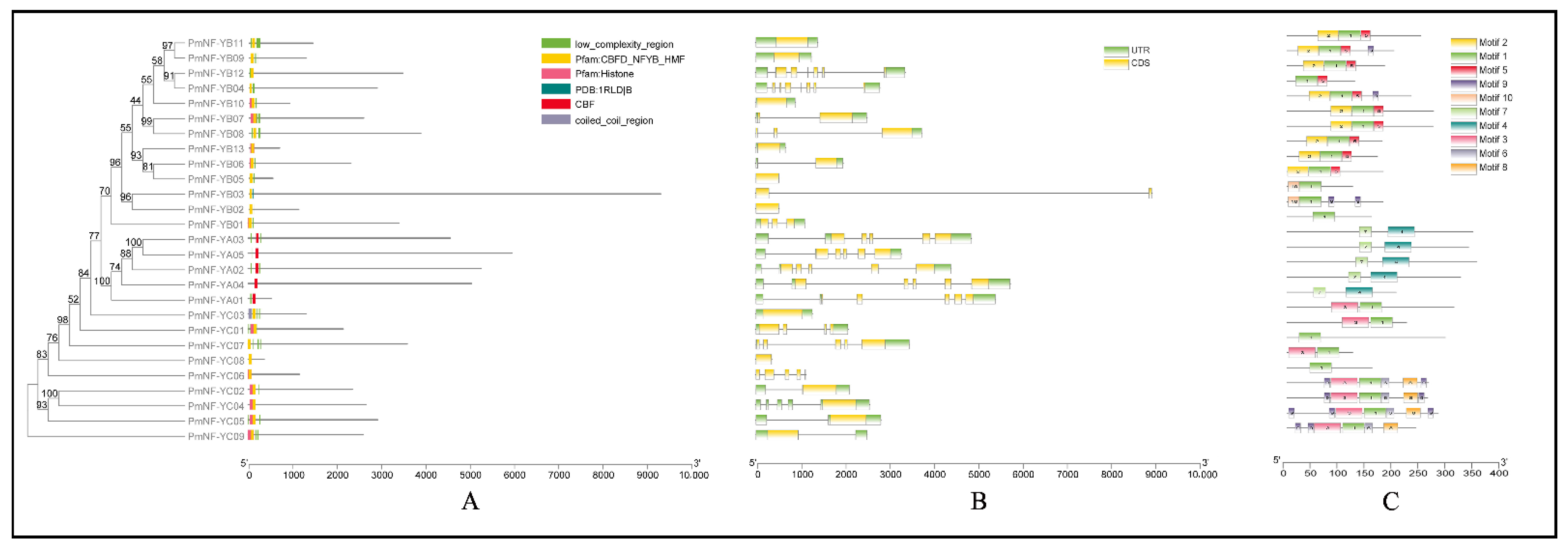

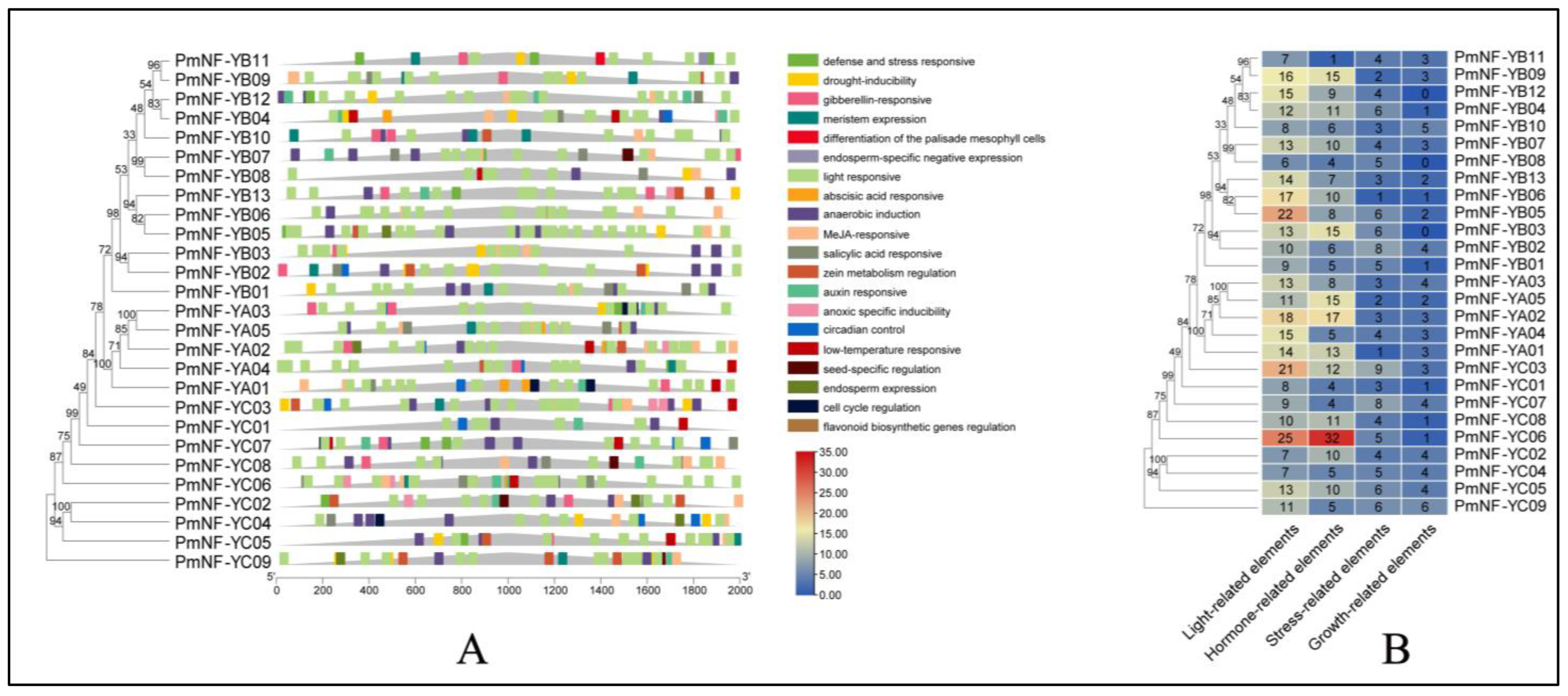
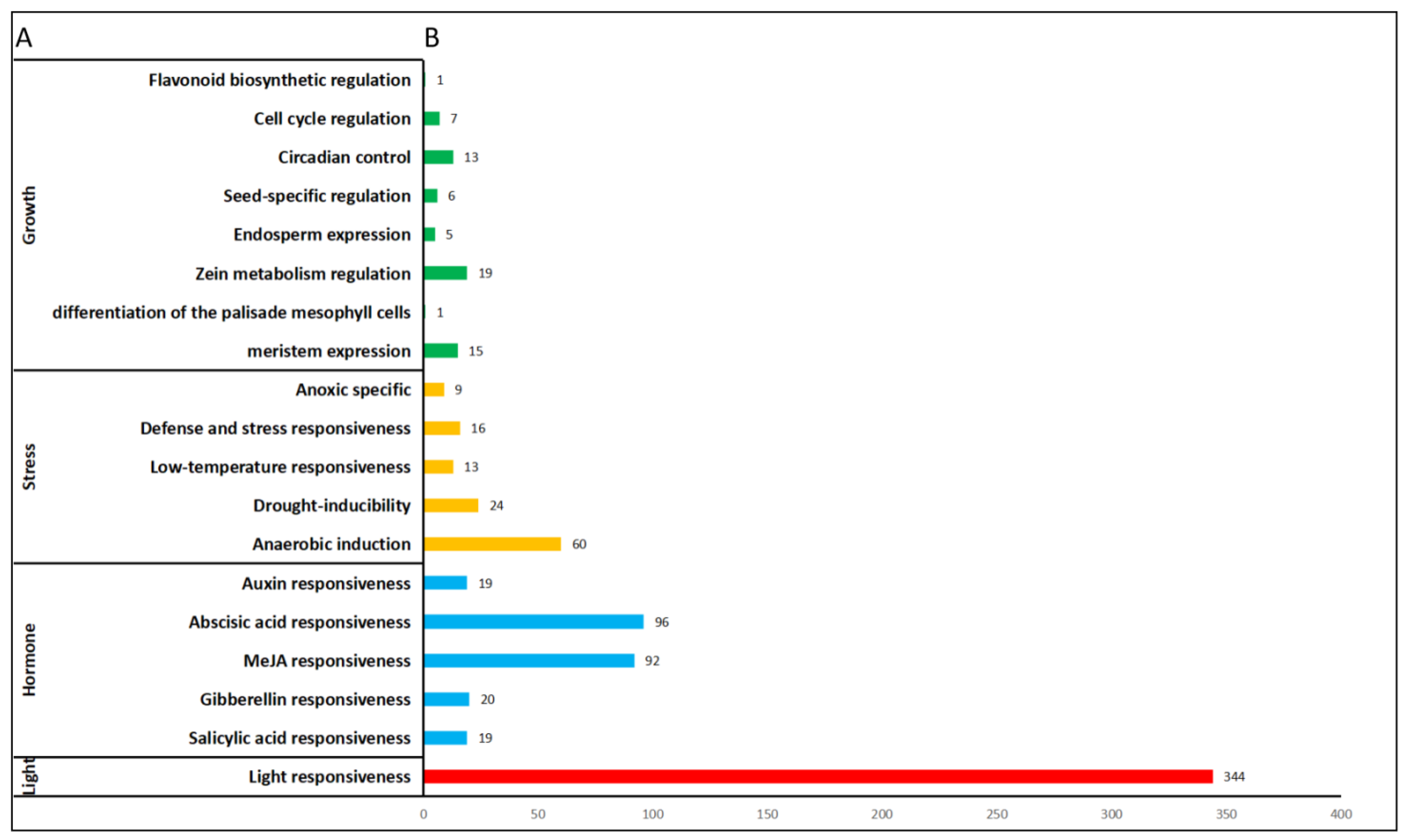
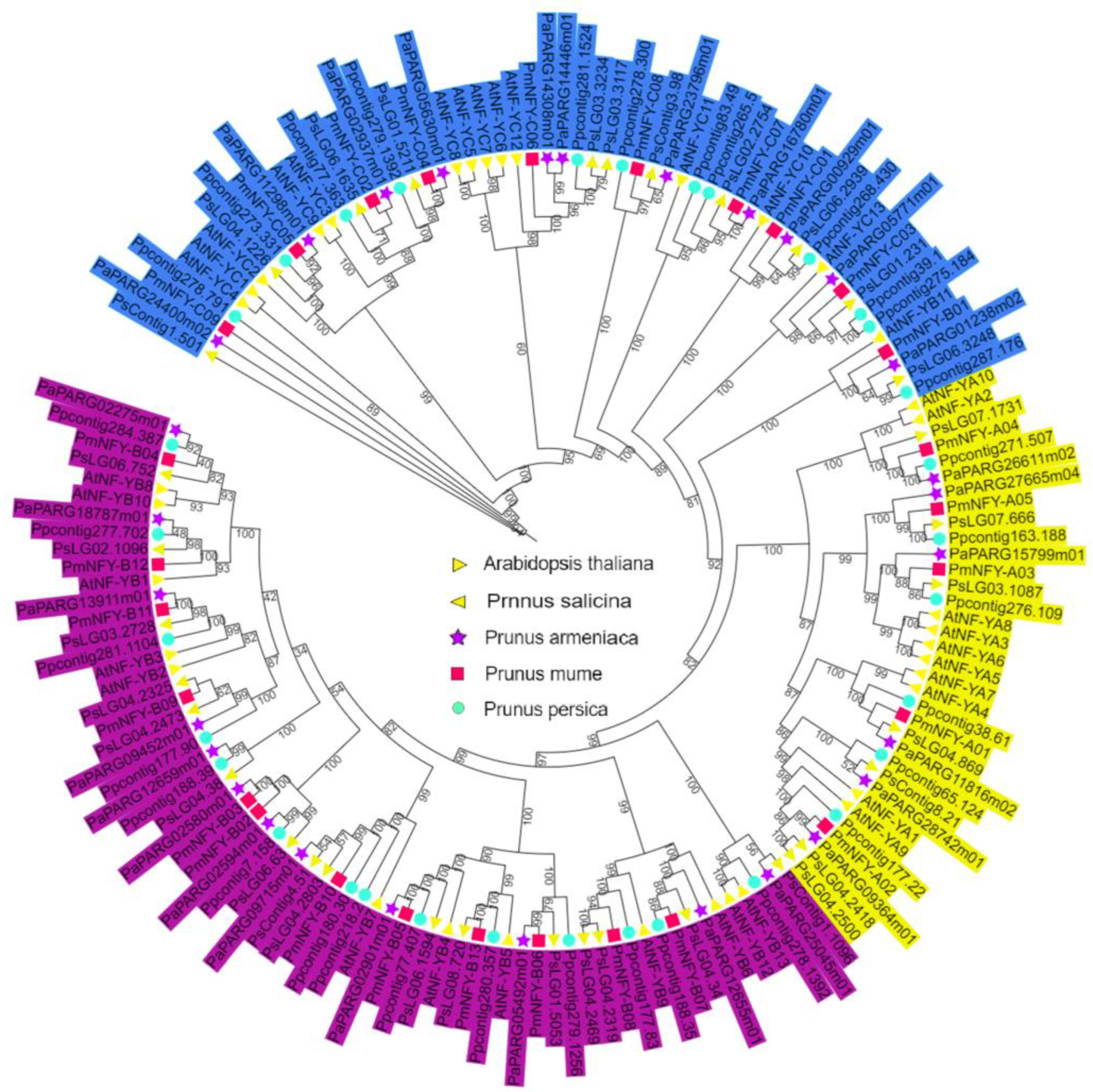
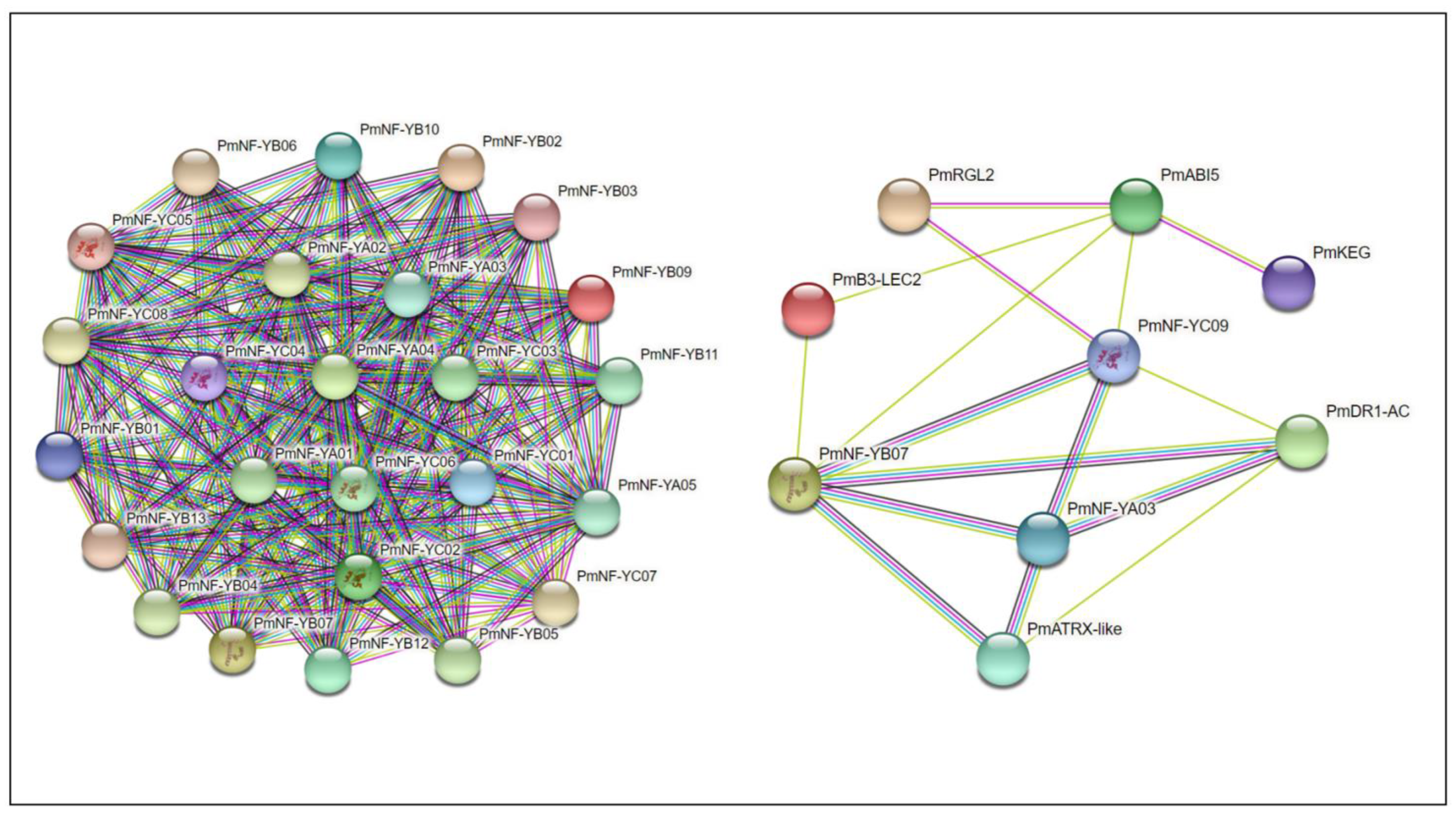

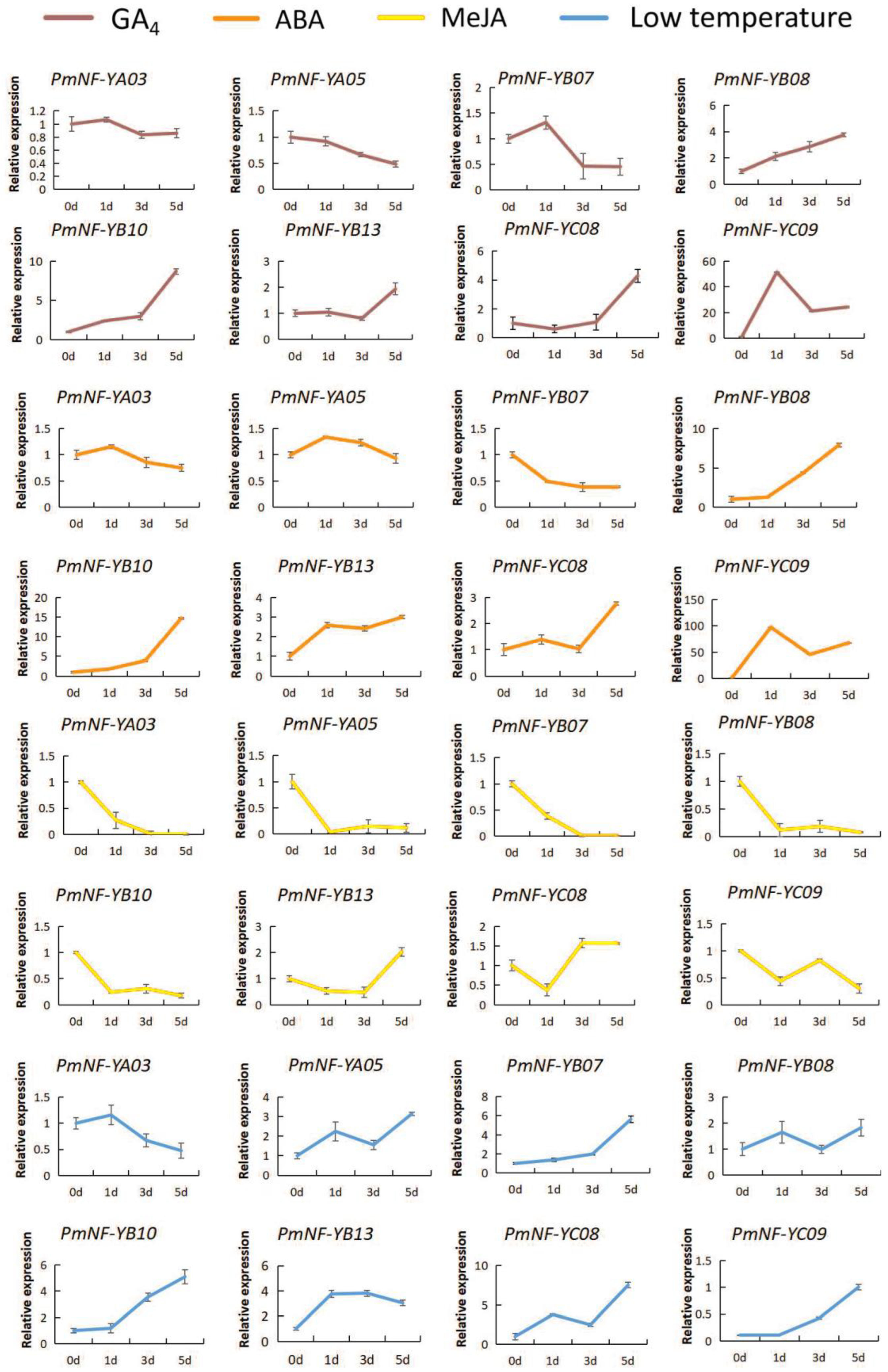
| Gene Name | Gene ID | Chr Location | Protein | Subcellular Localization | Signal Pep | ||||
|---|---|---|---|---|---|---|---|---|---|
| Length | MW | pI | GRAVY | Aliphatic Index | |||||
| PmNF-YA01 | LOC103325228 | 3 | 202 | 22,125.34 | 7.9 | −0.957 | 57.08 | Nucleus | No |
| PmNF-YA02 | LOC103326841 | 3 | 351 | 38,168.4 | 6.7 | −1.088 | 43.99 | Nucleus | No |
| PmNF-YA03 | LOC103327655 | 4 | 344 | 38,208.65 | 9.2 | −0.682 | 62.91 | Nucleus | No |
| PmNF-YA04 | LOC103339547 | 8 | 321 | 35,232.58 | 9.36 | −0.628 | 57.17 | Nucleus | No |
| PmNF-YA05 | LOC103340551 | 8 | 336 | 37,422.9 | 8.97 | −0.633 | 65.03 | Nucleus | No |
| PmNF-YB01 | LOC103328056 | 1 | 156 | 17,228.58 | 8.69 | −0.932 | 73.27 | Nucleus | No |
| PmNF-YB02 | LOC103332583 | 1 | 177 | 19,690.54 | 7.01 | −0.976 | 55.65 | Nucleus | No |
| PmNF-YB03 | LOC103332591 | 1 | 121 | 13,397.32 | 7.78 | −0.392 | 74.21 | Chloroplast Nucleus | No |
| PmNF-YB04 | LOC103338011 | 1 | 125 | 13,437.67 | 5.12 | −0.908 | 41.44 | Nucleus | No |
| PmNF-YB05 | LOC103344608 | 1 | 178 | 19,906.28 | 5.27 | −0.711 | 73.03 | Nucleus | No |
| PmNF-YB06 | LOC103322992 | 2 | 167 | 18,773.74 | 6.1 | −0.998 | 62.57 | Nucleus | No |
| PmNF-YB07 | LOC103324365 | 3 | 271 | 29,604.61 | 6.38 | −0.615 | 62.03 | Nucleus | No |
| PmNF-YB08 | LOC103326701 | 3 | 270 | 29,266.53 | 5.66 | −0.688 | 55.41 | Nucleus | No |
| PmNF-YB09 | LOC103326707 | 3 | 198 | 21,263.44 | 6.52 | −0.844 | 54.19 | Nucleus | No |
| PmNF-YB10 | LOC103326937 | 3 | 230 | 25,917.53 | 6.25 | −0.957 | 64.87 | Nucleus | No |
| PmNF-YB11 | LOC103329260 | 4 | 247 | 25,666.21 | 7.09 | −0.711 | 52.11 | Nucleus | No |
| PmNF-YB12 | LOC103332417 | 5 | 180 | 19,173.22 | 5.27 | −0.696 | 60.78 | Nucleus | No |
| PmNF-YB13 | LOC103333886 | 6 | 176 | 19,826.99 | 6.39 | −0.91 | 61.53 | Nucleus | No |
| PmNF-YC01 | LOC103325121 | 1 | 221 | 25,077.53 | 9.64 | −1.294 | 50.32 | Nucleus | No |
| PmNF-YC02 | LOC103344662 | 1 | 262 | 29,161.91 | 5.89 | −0.581 | 66.72 | Cytoplasm Nucleus | No |
| PmNF-YC03 | LOC103322124 | 2 | 309 | 34,672.45 | 4.35 | −1.086 | 64.24 | Nucleus | No |
| PmNF-YC04 | LOC103322822 | 2 | 260 | 28,835.56 | 5.89 | −0.499 | 73.62 | Nucleus | No |
| PmNF-YC05 | LOC103325736 | 3 | 280 | 31,364.25 | 5.76 | −0.622 | 69.75 | Nucleus | No |
| PmNF-YC06 | LOC107880919 | 4 | 157 | 18,073.58 | 6.19 | −0.568 | 77.01 | Nucleus | No |
| PmNF-YC07 | LOC103330752 | 5 | 293 | 31,620.66 | 4.84 | −0.717 | 67.06 | Nucleus | No |
| PmNF-YC08 | LOC103337511 | 7 | 121 | 13,301.29 | 6.91 | −0.273 | 77.36 | Nucleus | No |
| PmNF-YC09 | LOC103338075 | 7 | 238 | 26,082.18 | 5.14 | −0.535 | 67.69 | Cytoplasm Nucleus | No |
| Repeat Sequences | Ka | Ks | Ka/Ks | Type |
|---|---|---|---|---|
| PmNF-YB02/PmNF-YB03 | 0.310 | 0.3742 | 0.8305 | Tandem |
| PmNF-YB10/PmNF-YB11 | 0.7122 | NaN | NaN | Segmental |
| PmNF-YB06/PmNF-YB13 | 0.3622 | NaN | NaN | Segmental |
Publisher’s Note: MDPI stays neutral with regard to jurisdictional claims in published maps and institutional affiliations. |
© 2022 by the authors. Licensee MDPI, Basel, Switzerland. This article is an open access article distributed under the terms and conditions of the Creative Commons Attribution (CC BY) license (https://creativecommons.org/licenses/by/4.0/).
Share and Cite
Gao, F.; Huang, X.; Segbo, S.; Coulibaly, D.; Wang, R.; Ma, C.; Bai, Y.; Zhou, P.; Tan, W.; Ma, Y.; et al. Identification and Functional Analysis of Transcription Factor NF-Y Family during Flower Bud Dormancy in Prunus mume. Horticulturae 2022, 8, 1180. https://doi.org/10.3390/horticulturae8121180
Gao F, Huang X, Segbo S, Coulibaly D, Wang R, Ma C, Bai Y, Zhou P, Tan W, Ma Y, et al. Identification and Functional Analysis of Transcription Factor NF-Y Family during Flower Bud Dormancy in Prunus mume. Horticulturae. 2022; 8(12):1180. https://doi.org/10.3390/horticulturae8121180
Chicago/Turabian StyleGao, Feng, Xiao Huang, Silas Segbo, Daouda Coulibaly, Rui Wang, Chengdong Ma, Yang Bai, Pengyu Zhou, Wei Tan, Yufan Ma, and et al. 2022. "Identification and Functional Analysis of Transcription Factor NF-Y Family during Flower Bud Dormancy in Prunus mume" Horticulturae 8, no. 12: 1180. https://doi.org/10.3390/horticulturae8121180
APA StyleGao, F., Huang, X., Segbo, S., Coulibaly, D., Wang, R., Ma, C., Bai, Y., Zhou, P., Tan, W., Ma, Y., Ni, Z., Shi, T., & Gao, Z. (2022). Identification and Functional Analysis of Transcription Factor NF-Y Family during Flower Bud Dormancy in Prunus mume. Horticulturae, 8(12), 1180. https://doi.org/10.3390/horticulturae8121180






